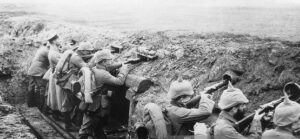Being a Friday, today's post will be a little more abstract.
A friend of mine recently showed me a book of photos from the First World War. One image in particular caught my interest. Unfortunately it is not practical to scan the image. Instead I have found another photo showing the same points of interest. From the uniforms it is from the same time period and may even be the same trench section. Here is the photo.

What I find interesting is how firing ports have been created by simply burying a pipe in the rampart. Further along you can see that a rectangular firing slot has been created using planks, probably from shipping boxes.
In most trenches troops fire over the parapet or cut crenels to fire through. Some trenches do use firing slots but constructed in a parapet of sandbags. The approach seen in this photo is much simpler. There are no sandbags to reveal the exact position of the trench. No heads have to be raised above the parapet. There are no crenels that are obvious targets for suppressive fire. The outer ends of the pipes and slots are probably hard to discern.
A pipe would only provide a narrow field of fire but this is not a problem if they are arranged for mutually supporting interlocking fields of fire. At Iwo Jima may of the highly effective Japanese positions were constructed with a narrow field of fire. The only way they could be engaged was to attack head on, which put you within the firearc of many other positions.
One wonders what sort of sight picture firing down a pipe provides. Certainly light glinting off the sights would not be a problem!
Modern troops still use earthworks and I wonder how few use techniques as simple but effective as those shown above? If you have a hide from which you hunt sharp-eyed game the buried pipe(s) idea might be worth considering.